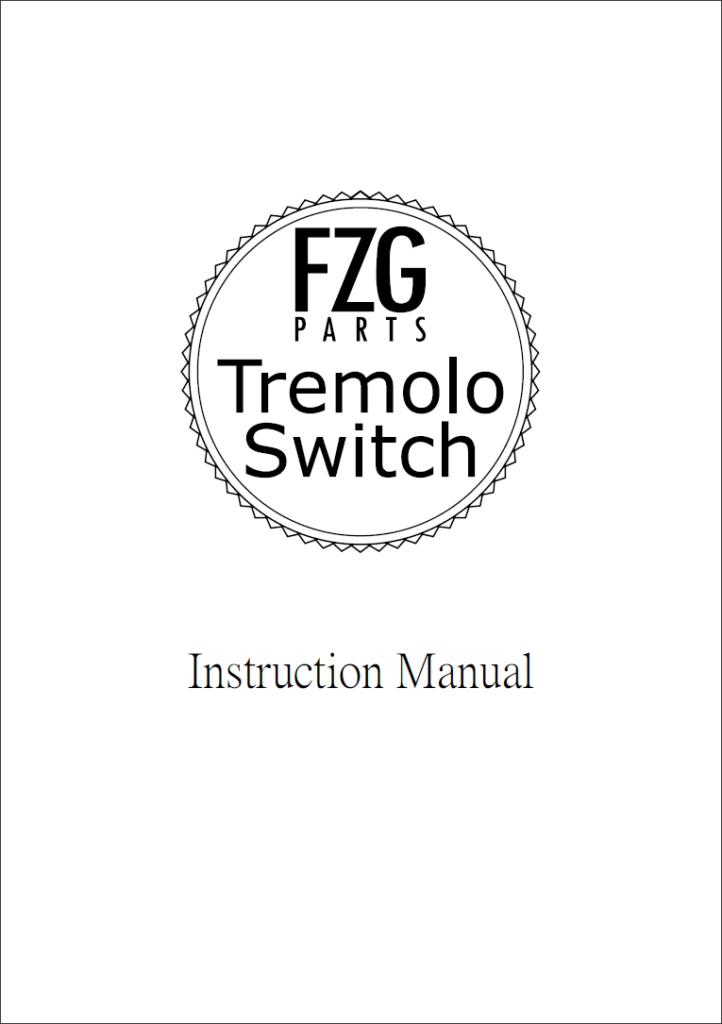Installation
Installation
- First remove the stop screw of the tremolo switch.
- Place the tremolo switch in the tremolo compartment so that the front edge is flush with or behind the cutout for the tremolo block. Make sure that there is enough space to adjust the stop screw in both directions.
Note: You can either position the Tremolo Switch in the center of the tremolo compartment – this way you can install up to four springs – or offset it upwards towards the bass strings if you prefer your tremolo setup with three springs (one spring in the center).
- Mark the front hole for the countersunk screw. It’s best to use a center punch for this so that the drill doesn’t slip when you put it in place. To prevent paint from chipping, you can mask the drill hole with tape beforehand.
- Pre-drill the hole with a 2mm drill bit. Then screw the Tremolo Switch with the countersunk screw so that it can still be turned easily.
- Screw the stop screw (M4) back into the bolt and unscrew it until the screw head is in full contact with the tremolo block. The Tremolo Switch should be aligned as perpendicular as possible to the tremolo block.
- Pre-drill the rear hole as described in steps 3 and 4 and screw in the remaining screw. The rear hole has no centering. This means that the alignment of the Tremolo Switch can still be slightly corrected. Check the perpendicularity to the tremolo block again!
- Remove the stop screw once more and tighten the front countersunk screw. Afterwards it can be screwed in again and the Tremolo Switch can now be fine-tuned. In the following two variants for the correct adjustment are described below.
Setup: Variant 1
The following procedure describes the adjustment in case the tremolo is already perfectly adjusted, i.e. the base plate is parallel to the surface of the body and the tremolo block is perpendicular to it.
Unscrew the stop screw (M4) of the Tremolo Switch until the screw head just makes contact with the tremolo block. If you can observe a movement of the tremolo block, the stop is already turned out too far. Keep in mind that a minimal movement of the tremolo block when activating the Tremolo Switch already causes quite a large detuning.
The stop should also be adjusted in playing position, i.e. the guitar should be in front of you and not lying flat on a table with the back facing you. Gravity affects the resting position of the tremolo, which is why a Tremolo Switch that is perfectly adjusted in the lying position can suddenly cause slight detuning when activated in the playing position.
Check the stop setting every now and then with a tuner. Ideally, no detuning should occur when the Tremolo Switch is activated. If the stop is turned out too far, it will push the tremolo slightly forward, causing a downward detune.
You should also check the play between the tremolo block and the stop by pushing the tremolo block slightly against the stop. If the tremolo block can be moved noticeably, there is too much gap between the stop and the tremolo block. This play is responsible for an upward detune when you want to drop-tune the guitar.
When the stop is perfectly adjusted, secure the position of the stop screw with the lock nut on the stop bolt. When tightening, make sure that the stop screw does not turn back in with it. It is best to use a second open-end wrench to hold the stop screw in place.
Setup: Variant 2
You can also put the cart before the horse by taking advantage of the fact that the stop of the Tremolo Switch determines the rest position of the tremolo:
First, deliberately set the tremolo’s spring tension a little higher so that the tremolo block pulls back and the base plate is thus no longer parallel to the surface of the body. Then activate the Tremolo Switch. The stop screw should already make contact with the tremolo block and push it forward a little. Now turn out the stop screw until the tremolo block is vertical and the base plate of the tremolo is parallel to the surface of the body again.
When this is done, secure the position of the stop screw with the lock nut on the stop bolt. When tightening, make sure that the stop screw does not turn back in with it. It is best to use a second open-end wrench to hold the stop screw in place.
Now tune the guitar and check the contact of the stop with the tremolo block. If the tremolo block is still in contact, reduce the spring tension until it just lifts off the stop. Note that the guitar will go out of tune when the spring tension is reduced. Therefore, each time you change the spring tension, you should also retune the strings. Retuning in turn causes the tremolo block to move. Balancing the spring tension is therefore an iterative process, which is why it is not helpful to screw only one side of the force equilibrium.
If the tremolo block already lifts from the stop after the first retuning, you have to go the opposite way and increase the spring tension step by step.
For the most exact alignment of the stop, adjust the tremolo switch in playing position as described in variant 1.

